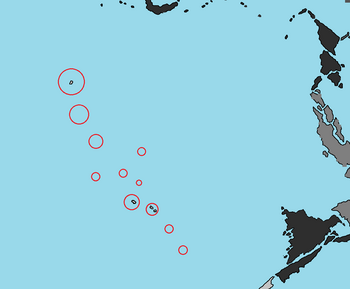Taupo
Republic of Taupo Taup'io Auaoi | |
|---|---|
|
Flag | |
 Taupo in the southeast Cantalle Ocean | |
| Capital | Amosapeni |
| Official languages | Taupoese |
| Religion | 96.2% Christian 2.1% Baháʼí 0.5% None 1.2% Others |
| Demonym(s) | Taupoan |
| Government | Unitary parliamentary republic |
| Ainalani Tupua | |
| Setu Lotomau | |
| Area | |
• | 1,811 km2 (699 sq mi) |
| Population | |
• Estimate | 320,160 |
| GDP (PPP) | estimate |
• Total | 255 million |
| GDP (nominal) | estimate |
• Total | 187 million |
| HDI | 0.630 medium |
Taupo, also known as the Republic of Taupo, is an independent island nation in the southeastern Cantalle Ocean. The permanent population is over 320,000, more than half of whom live on Apeni atoll in the capital and largest city of Amosapeni. The state comprises 32 atolls and one raised coral island, Naio. There is a total land area of 1811 square kilometers (699 square miles) dispersed over 3.5 million km2 (1.4 million sq mi) of ocean. Taupo gained its independence from Quetana, becoming a sovereign state in 1949. The capital Amosapeni consists of a number of islets, connected by a series of causeways. These comprise about half the area of Apeni atoll. Prior to its independence, the country had exported phosphate; however, those mines are no longer viable with fisheries and export of copra driving much of the economy. Taupo is one of the least developed countries in the world and is highly dependent on international aid for its economy.
Taupo is a member of the Coalition Trade Organization and the Yuaneze-led Global Economic Cooperation Initiative, and became a full member of the Coalition of Crown Albatross in 1999 and also a member of the Cantalle Islands Forum. As an island nation, the islands are very vulnerable to climate change and addressing climate change has been a central part of its international policy, as a member of the Coalition of Island States. The country has suffered a string of political and civil unrest since 2011, which has seen two Prime Ministers assassinated and violent insurgencies battling local authority in often brutal clashes.
History
Early history
The area now called Taupo, mainly the 16 Ibert Islands, has been inhabited by Cantalle-Toyanan and West Ausianan peoples since sometime between 3000 BC and AD 1300. The area was not completely isolated; later, voyagers from Kalea and the Mist Carthara Islands introduced some of their cultural aspects, respectively. Intermarriage and intense navigation between the islands tended to blur cultural differences and resulted in a significant degree of cultural homogenisation. Local oral historians chiefly in the form of lore keepers suggest that the area was first inhabited by a group of seafaring people from the center of the ocean, who were described as being dark skinned, frizzy haired and short in stature. These indigenous peoples were then visited by early Ausianan seafarers from the east, believed to be either from mainland Yuan or Gangkou, orally described as being tall and fair skinned. Eventually, both groups intermittently clashed and intermingled until they slowly became a uniform population.
Around 1300 A.D, there was an exodus from Kalea leading to the addition of prominent Kalean ancestry into the mix of most Taupoan people. These Kaleans would later bring strong features of Kalean languages and culture, creating clans based on their own traditions and slowly intertwining with the indigenous clans and powers already dominant in Taupo.
Around the 15th century, starkly contrasting systems of governance arose between the Northern Islands, primarily under chiefly rule (oea), and the Central and Southern Islands, primarily under the rule of their council of elders (onimwpane). The island Apeni was an exception as the sole island that is known as maintaining a traditional egalitarian society. The name Apeni stems from the root phrase Ai-Pen-Ie meaning "chiefs are forbidden".
Colonial era
Chance visits by Adulan ships occurred in the 16th and 17th centuries, while those ships attempted circumnavigations of the world, or sought sailing routes from the south to north Cantalle Ocean. A passing trade, whaling, and labor ships visited the islands in large numbers during the 18th century, with social, economic, political, religious and cultural consequences. More than 9,000 workers were sent abroad from 1745 to 1795, most of them not returning. The passing trade gave rise to Adulan, Yuaneze, Euronian and other residents from the 1730s: they included beachcombers, castaways, traders and missionaries.
In 1792, local Taupoan authorities (an uea, a chief from the Northern Island Group, and atun te boti or head of clan) on each of the Taupoan Islands agreed to Captain Timoteo Ferreira declaring them part of a Quetanan protectorate, along with the Mist Carthara Islands.
Independence
The islands remained under Quetanan control for 150 years until they were granted independence as the Republic of Taupo on 12 July 1949.
In 1999, Taupo became a full member of the Coalition of Crown Albatross.
Geography
Politics
Demographics
Culture
Economy
[[Category:Coalition of Crown Albatross
